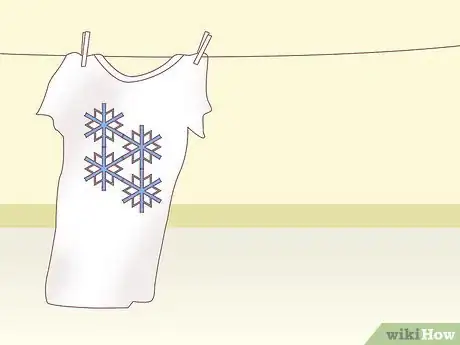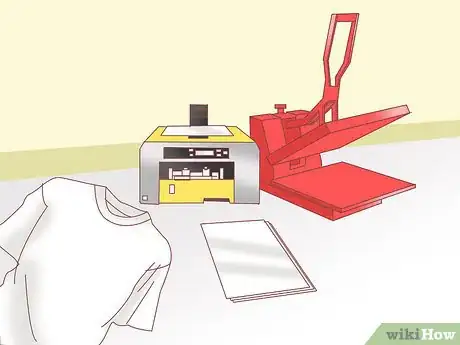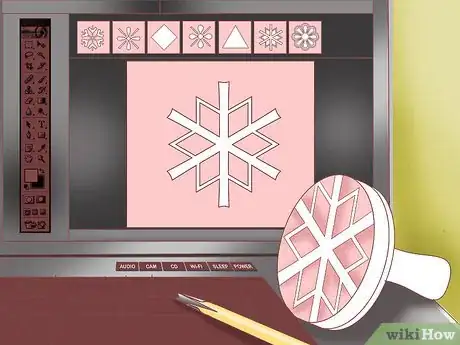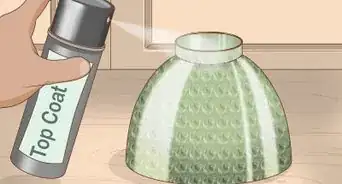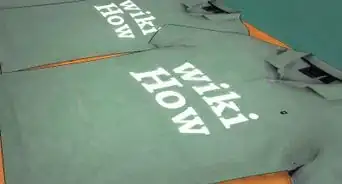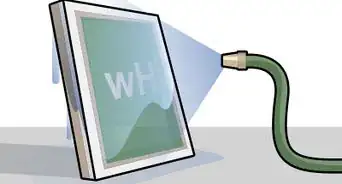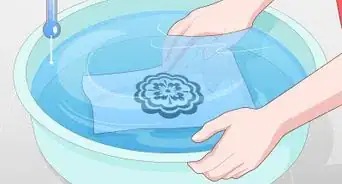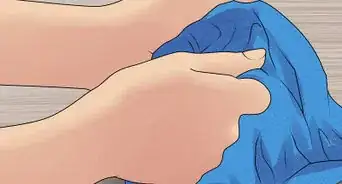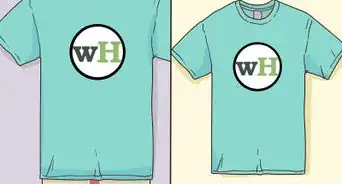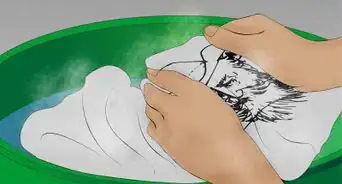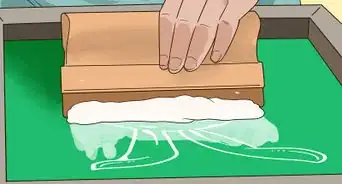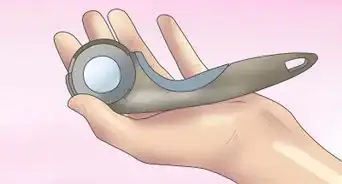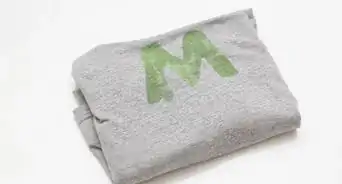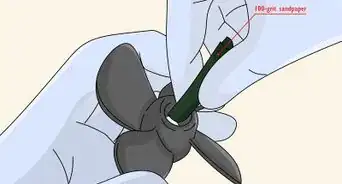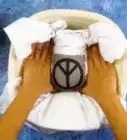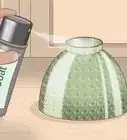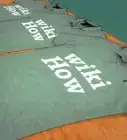This article was co-authored by wikiHow Staff. Our trained team of editors and researchers validate articles for accuracy and comprehensiveness. wikiHow's Content Management Team carefully monitors the work from our editorial staff to ensure that each article is backed by trusted research and meets our high quality standards.
There are 19 references cited in this article, which can be found at the bottom of the page.
This article has been viewed 91,150 times.
Learn more...
Most craft or fabric stores will have a variety of designer fabrics to choose from for whatever project you have in mind. However, it can be cheaper and infinitely more fun to create your own. Designing and printing your own fabric gives you the freedom to express yourself with different textile projects, such as quilting projects, homemade clothing, or any other textile creation. Unlike screen printing, all you'll need is either a stamp for block printing or an inkjet printer for a digital alternative.
Steps
Printing Fabric With Stamps
-
1Create a stamp to create a design. Sketch out an image or design onto a linoleum block with a pencil. This gives you the option of tweaking the design before you start to carve. Then, use a carving knife or a carving tool from a craft supply store to whittle away the block until only your design is left. The deeper you cut away the excess linoleum, the less likely you'll end up with smudges on your fabric.
- Keep your first trial run simple. Use an image with few colors and clear lines so that you can determine how your printer places ink on your fabric before moving on to more complicated patterns and images.
- Common designs for beginning to block print can be squares and triangles since they can overlap and repeat in geometric designs, or abstract images since it requires less accuracy with carving straight lines.[1]
- Remember that if you carve a design, the raised part will be what is printed on your fabric so be aware of negative space when drawing up your design.
- Linoleum is the most common material for block printing. Other options include a piece of wood, a large rubber eraser that can be carved into like wood, or any kind of household item that could leave an interesting print.[2]
-
2Pick out paint for your project. You'll first want to decide if you want to use one color or more in the overall design. Then, make sure you have paints that are oil-based or are meant for fabric.
- Oil-based paints will take much longer to dry but they have a much richer texture. Oil-based paint stains are also notoriously difficult to get out of fabric which is why a solvent is required, but that's good news for your fabric because it will not wash out easily or quickly.[3] If you're going to use oil-based paint, make sure you have a solvent on hand that can help clean up any stains.
- Fabric paints can work as well but they do not apply to fabrics as smoothly as oil-based paints.
- Both kinds of paints can be washed, but it's best to treat your fabric after printing and read the instructions for care for your particular paint.
Advertisement -
3Brush the paint onto the block or stamp. You can dip your block in paint and paint try but using a foam brush or foam roller to lightly coat the surface is better. This way you'll get a more even coverage and won't end up with large globs of paint.
- Excess paint can drip and create an uneven design, but you may find that you want a more uneven design that looks more natural rather than a uniform pattern.
- You can also you a finer tipped paintbrush to apply paint. With this method you can use more than one color paint as well since you'll have more control over where the paint is on your stamp. Make sure that you keep any different paint colors that you use separate so that you can avoid mixing and keep the colors crisp.
- Be careful to avoid getting too much paint on the rest of the stamp when coating it. If you press the stamp off-kilter you could end up with random splotches of paint within your design.
-
4Practice first. Use a scrap piece of fabric or paper to make sure that you can align your stamp correctly or that you get the impression you wanted. This is where you can check for imperfections in your stamp design. You also should practice how you want to space out your stamps if you are aiming for a repeating pattern.
-
5Press your stamp on to the fabric on a flat surface. Place some cardboard or drop cloth underneath the fabric so that if any paint bleeds through it won't ruin your surface underneath and any excess paint will be absorbed. When block printing on a double-sided material, protect the other side by slipping a piece of cardboard in between.[4]
- You can choose to create a uniform pattern or not. For example, you can alternate shapes or colors in a repeating pattern that covers the whole fabric, or you could sporadically stamp and leave large blank spaces.
- Stripes are an easy-to-replicate pattern as well as polka-dots.
- But as you go, make sure to press the stamp straight down on the fabric and lift up straight up as well. Pressing or lifting on an angle will disperse the paint unevenly. [5]
- Additionally, stamping with different amounts of pressure will create a distressed look which you may or may not desire. This is where you can truly customize your fabric based on how you utilize the stamp.
-
6Allow your fabric to dry. Do not handle it immediately or the ink may bleed. For best results, place the fabric gently over a cooling rack used for baking or dry ground before folding or handling. The fabric will need anywhere from a day to a few days to dry completely before it will be completely set. After the paint dries, you can use your fabric for anything.
Printing Fabric Using a Computer
-
1Buy fabric that can be printed on by an ink-jet printer. You'll want either a 100% cotton or silk with a tight fiber weave for best resolution so the ink will stick and your image will be clearer.[8]
- You can find pretreated and precut fabric for printing at craft stores. These are usually already stiffened for printing. This method will save you other steps in preparing your own fabric pieces but can also be more expensive.[9]
- You will also need a fabric stabilizer. Fabric will not feed as easily into a printer as regular paper does so you will need to attach a stabilizer to guide it through your printer without it jamming. Options include freezer paper ironed shiny side down to the back of the fabric, 8.5"x11" office stickers stuck to the back of the fabric, cardstock with spray adhesive or tape,[10] or fusible webbing.[11]
-
2Attach a stabilizer and cut your fabric to size. Iron out your fabric on a dry setting so that you don't have any bumps or wrinkles while attaching the stabilizer. Then, lint roll the fabric to pick up any stray fibers that will get in the way of printing and produce a smudged image. Use a craft cutting mat with a grid printed on it for accuracy to measure out a piece of fabric that will fit through your printer. Most printers have the capacity to print on 8.5"x11" pieces.
- For freezer paper, cut a piece of paper to the size your printer takes and iron it shiny side down onto the fabric, then cut the fabric to size using scissors or a rotary blade.
- Or, you can cut the fabric to size, iron an uncut piece of freezer paper to the fabric, and then trim the sides of the freezer paper so that the edges line up perfectly.[12] It can help to leave about 2 inches of stabilizer to feed through the printer rollers to catch the material.
- Office supply stickers or labels are also efficient to use. You can peel off a label and stick it to your fabric and then trim as needed. These labels won't leave much residue if any and they come pre-sized for printing.[13]
- If you use spray adhesive or a spray-on chemical to stiffen the fabric, make sure you have a drop cloth or other protective surface beneath it. Don't oversaturate the fabric or it will become too stiff to use once it's printed. After spraying, let it dry completely before feeding through your printer so it doesn't get jammed.
-
3Check your printer and ink cartridges to make sure they are compatible with fabric printing. The best kind of at-home printer to use unless you are looking to print commercially is an ink-jet printer that can use both dye and pigment ink cartridges.
- Dye ink is not water-resistant on its own but if you want to print with it, you can pretreat your fabric to be waterproof with chemical solutions like Bubble Jetset found at craft supply stores.
- Pigment ink is the best option and will be water-resistant with only a little leakage when its first washed.
- To find out what kind of ink cartridge you have or want to buy, look up the serial number online or use a search engine to find specific brands to use.[14]
-
4Start out with a simple design for your first project. Chances are you have an idea in mind for what you want to put on your fabric. You can use different mediums to create your design:
- Photos you have taken
- Drawings or paintings scanned into the computer
- Images or text pulled from the internet
-
5Use a photo-editing computer program or other website to edit your design. Whether you start out with a rough design on paper or a photo that you scan into the computer, you will want to upload it into an editing program to make it fabric-ready. There are several free programs, such as GIMP, PicMonkey, Aviary, and Inkscape, that are available online as well as software that you can buy for a more professional finish to your images such as Adobe Photoshop or Illustrator.
-
6Check your computer settings before printing. In many editing programs you can select different picture resolutions in the settings. You can always test out your design by printing on a normal piece of printer paper to make sure that everything is aligned correctly.
- Whichever measurement your computer uses for image resolution, whether it's pixels or DPI (dots per inch), select the highest setting so that you get the best quality print.[15]
- Additionally, check the color settings for your printer and computer and make sure that they are aligned.[16] You can use sites that translate hex and RGB color codes (two different ways to indicate to computer programs the color you want to use) to color correct your design.[17]
- Choose the highest resolution possible to ensure the best quality image for your design. Most computers have an option for "Printer Preferences" where you can select different options and for many, the option you should select is "Best Photo" quality.[18]
- Scout out other fabric printing websites for ideas and suggestions. There are several websites that provide printing services that also exhibit their client's designs in galleries so you can look through other's people's projects and gather ideas for your own fabrics. Popular sites include Spoonflower, Digital Fabrics, Woven Monkey, and Fabrics on Demand.
-
7Place the fabric in your printer and feed it through gently as it prints. Watch carefully as it prints to make sure that nothing gets snagged in the process. As the fabric prints out from the machine, catch the edge of it and keep it raised off of the printing tray so that any damp ink doesn't smudge or smear. Let the fabric sit out to dry on a flat surface before handling.
Warnings
- Never use a laser-printer to print your images. The fabric will ruin your laser-printer.⧼thumbs_response⧽
- Most printable fabric designs will fade if put into a machine washer or dryer. If you must use a washing machine, turn the clothing inside out and select cold water.⧼thumbs_response⧽
- Printable fabric is expensive, so as a cheap, but equally successful alternative, spray plain fabric with a solution of 3 parts water to 1 part polyvinyl alcohol and allow to dry.[19]⧼thumbs_response⧽
- Read your printer's instruction booklet to find out the best settings for printing on surfaces such as fabric.[20]⧼thumbs_response⧽
Things You'll Need
- fabric for whichever method you choose
- linoleum block or material to carve into
- carving tool
- paint tray
- Ink-jet printer
- printer ink
- photo-editing computer program
- Rotary blade or scissors
- cutting mat
- ruler
- An iron
- Sink or space to wash fabric
References
- ↑ http://www.apartmenttherapy.com/diy-block-printed-napkins-161906
- ↑ http://www.marthastewart.com/906821/block-printing#904491
- ↑ http://www.prettyprudent.com/2011/07/prudent-home/how-to-block-print-fabric-2/
- ↑ https://www.apartmenttherapy.com/block-printed-textiles-inspiration-diy-tips-175024
- ↑ https://www.plaidonline.com/blog/post/2015/06/01/how-to-hand-stamp-a-design-using-fabric-creations?utm_content=bufferdc216&utm_medium=social&utm_source=pinterest.com&utm_campaign=buffer
- ↑ http://thegraphicsfairy.com/how-to-make-graphic-print-pillow/
- ↑ http://www.prettyprudent.com/2011/07/prudent-home/how-to-block-print-fabric-2/
- ↑ http://www.instructables.com/id/Printing-Fabric-at-Home/?ALLSTEPS
- ↑ http://so-sew-easy.com/how-to-print-on-fabric-at-home/
- ↑ http://thegraphicsfairy.com/how-to-print-on-fabric/
- ↑ http://thesewingloftblog.com/printing-on-fabric/
- ↑ http://makezine.com/2010/07/07/how-to_print_on_fabric_with_an/
- ↑ http://www.myrepurposedlife.com/printing-on-fabric
- ↑ http://quilting.about.com/od/howtoprintonfabric/fl/How-to-Print-on-Fabric-with-Inkjet-and-Laser-Printers.htm
- ↑ http://www.tillyandthebuttons.com/2014/09/how-to-design-your-own-fabric.html
- ↑ http://www.rgbtohex.net/hextorgb/
- ↑ http://www.color-hex.com/
- ↑ http://thegraphicsfairy.com/print-fabric-freezer-paper-method-2/
- ↑ http://www.prettyprudent.com/2010/08/hot-mess/tips/confessions-of-an-adhesive-sealant-junkie-2/
- ↑ http://printscan.about.com/od/printerscannerspecs/a/scanbasics.htm
About This Article
To print your own fabric by hand, create a stamp by carving your design into a linoleum block. Next, buy oil-based or fabric paints in the colors you want to use. Then, brush the paint onto your stamp and give it a few trial runs on a piece of scrap fabric to make sure everything looks good. Finally, press the stamp straight down onto your chosen fabric and lift it straight up to evenly disperse the paint. Be sure to let the fabric dry completely before using it! To learn about sing a computer to create a design and print on fabric, read on!





